Central America is home to an abundance of colorful birds, including those that make their home in Costa Rica. Why are these birds so colorful? Mostly, according to biologists, to attract mates. You’ll notice that many (but not all) colorful birds are male, and the females tend to be a bit drab. Not only does the male coloration attract females, but it may also distract would-be predators. It’s better for a predator to go after a floridly colored male than to find a nest full of eggs or dependent chicks! Here are 16 colorful birds of Costa Rica.
1. Lovely Cotinga
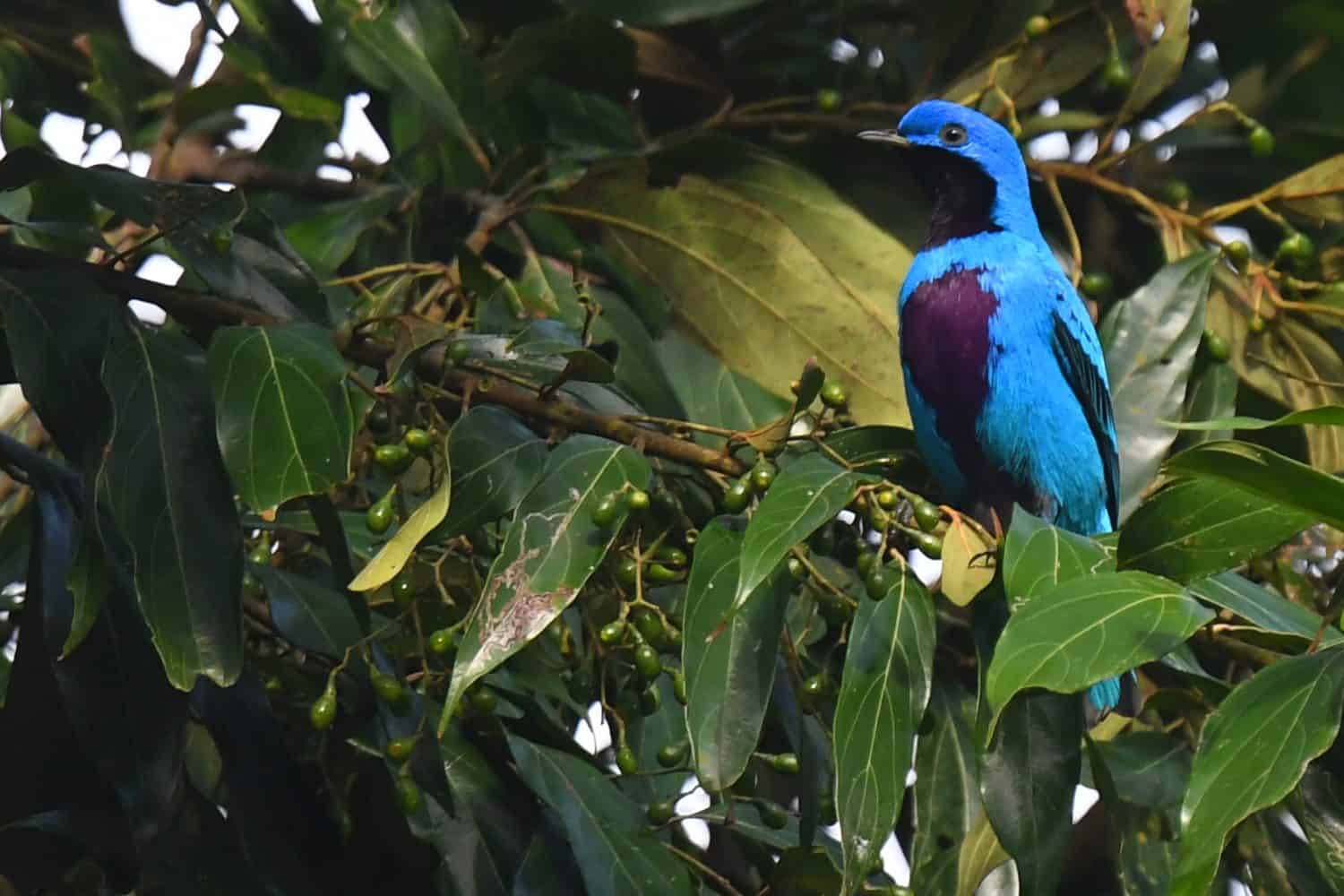
One of the most colorful birds in Costa Rica, the male lovely cotinga is blue and purple, while the female is brown.
©Lev Frid/Shutterstock.com
You’ll find this lovely bird in Costa Rica’s tropical forests. Adults are about 7.5 inches long. The male sports sapphire blue plumage, while the female is dull colored with a spotted breast and belly. He also has a purple bib and a large splash of purple on the breast, with black flight feathers edged in blue. The bird’s tail fathers are also black but covered with blue upper tail coverts. The lovely cotinga is a largely silent bird, but its wings make a rattling sound as the bird flies. Though its population has been affected by deforestation, the conservation status of this elusive bird remains least concern.
2. Vermilion Flycatcher

This male vermilion flycatcher perches on barbed wire and waits for prey.
©Ondrej Prosicky/Shutterstock.com
The males of this little bird are brilliant red or vermilion on their crowns and their underparts. Their faces, ear coverts and the back of their neck are deep brown as are their tails and the tops of their wings. The females are mostly gray, though their underparts turn pink. The vermilion flycatcher is about 5.12 to 5.51 inches long and weighs between 0.40 to 0.50 ounces. It gets its name because it snatches flying insects out of the air during sallies from one branch to the other.
The vermilion flycatcher lives in open areas such as farms, savannas, and dry scrubland. During the breeding season, the male starts to build a nest and tries to entice females to it. If she accepts, she’ll finish the nest and lay two to four eggs. The eggs hatch after 13 to 15 days and the chicks fledge 13 to 15 days after that. The female incubates the eggs, and the male feeds her. Later, both parents feed the chicks a diet of mostly caterpillars. Vermilion flycatchers live about 5.5 years and their conservation status is least concern.
3. Rufous Tailed Jacamar
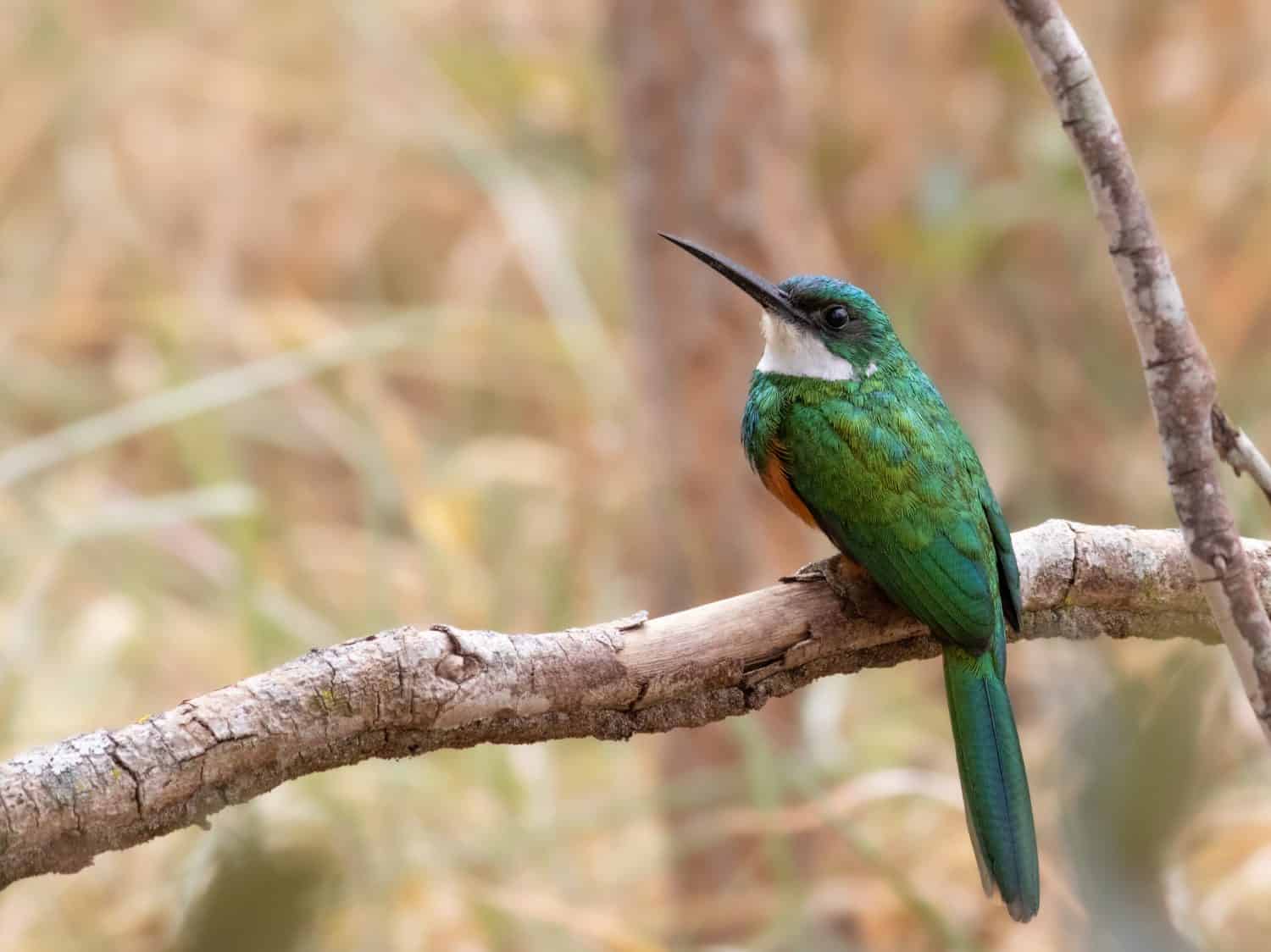
This bird looks somewhat like a
hummingbird
but eats insects.
©Vinicius Vianna/Shutterstock.com
This colorful bird, Galbula ruficauda, looks very much like a hummingbird, but it is an insectivore. In the case of this bird, both sexes are rather colorful. One subspecies has a metallic green dorsal side, a mostly green dorsal side, with a band of green across the breast. The male’s throat is white while the female’s is buff, and her dorsal area is a little paler. In another species the back is coppery. As the name says, the bird’s tail is rufous colored underneath.
The bird waits on a limb with its long bill tilted up. When an insect flies by, the bird flies out to catch it. Its favorite prey is a wasp called Agelaia vicina. These wasps are known for their huge colonies. Rufous tailed jacamars also eat other flying insects such as bees, butterflies, and dragonflies. They are able to tell which butterflies are palatable and which are toxic just from the insect’s shape. The rufous tailed jacamar’s conservation status is least concern.
4. Red-Capped Manakin

This colorful bird is famous for his courtship dance.
©Vaclav Sebek/Shutterstock.com
This little bird, which is only 4 inches long and weighs little more than half an ounce, is famous for the male’s courtship display. Basically, he woos a female by moonwalking back and forth on a branch. He is a deep black save his head and the back of his neck, both of which are brilliant red. His thighs are yellow, as are his chin and the linings of his wings. He also has startling white irises. The female is a shade of olive green with some yellow green beneath, and her irises are brown.
This bird is found in Costa Rica’s woods and humid forests and eats fruit. Because of this, red-capped manakins help to repopulate the forests thanks to the seeds found in their droppings.
5. Painted Bunting

These birds, also called Mexican canaries, are members of the cardinal family.
©Danita Delimont/Shutterstock.com
The painted bunting is a type of cardinal. One subspecies, Passerinaciris pallidior, breeds in Ecuador. It’s found in open areas with a smattering of thickets and brush.
This bird is between 4.72 to 5.12 inches long and weighs between 0.46 and 0.67 ounces. The male’s plumage is a beautiful mix of bright blue on the head and back of the neck, bronzy green back, and red throat and ventral area. The females have a dark green dorsal area and are yellowish green beneath. Both male and female have dark feet, legs, and eyes.
During the breeding season the female painted bunting builds the nest then lays an average of four eggs. She’ll incubate them for 11 days and is the only parent who cares for the chicks, who fledge about two weeks after they hatch. Painted buntings often have two broods a year, about a month apart. Catching these birds for the pet trade used to be commonplace but is now illegal even though some poaching occurs. Despite habitat loss, the conservation status of the painted bunting is least concern.
6. Rosy Thrush Tanager
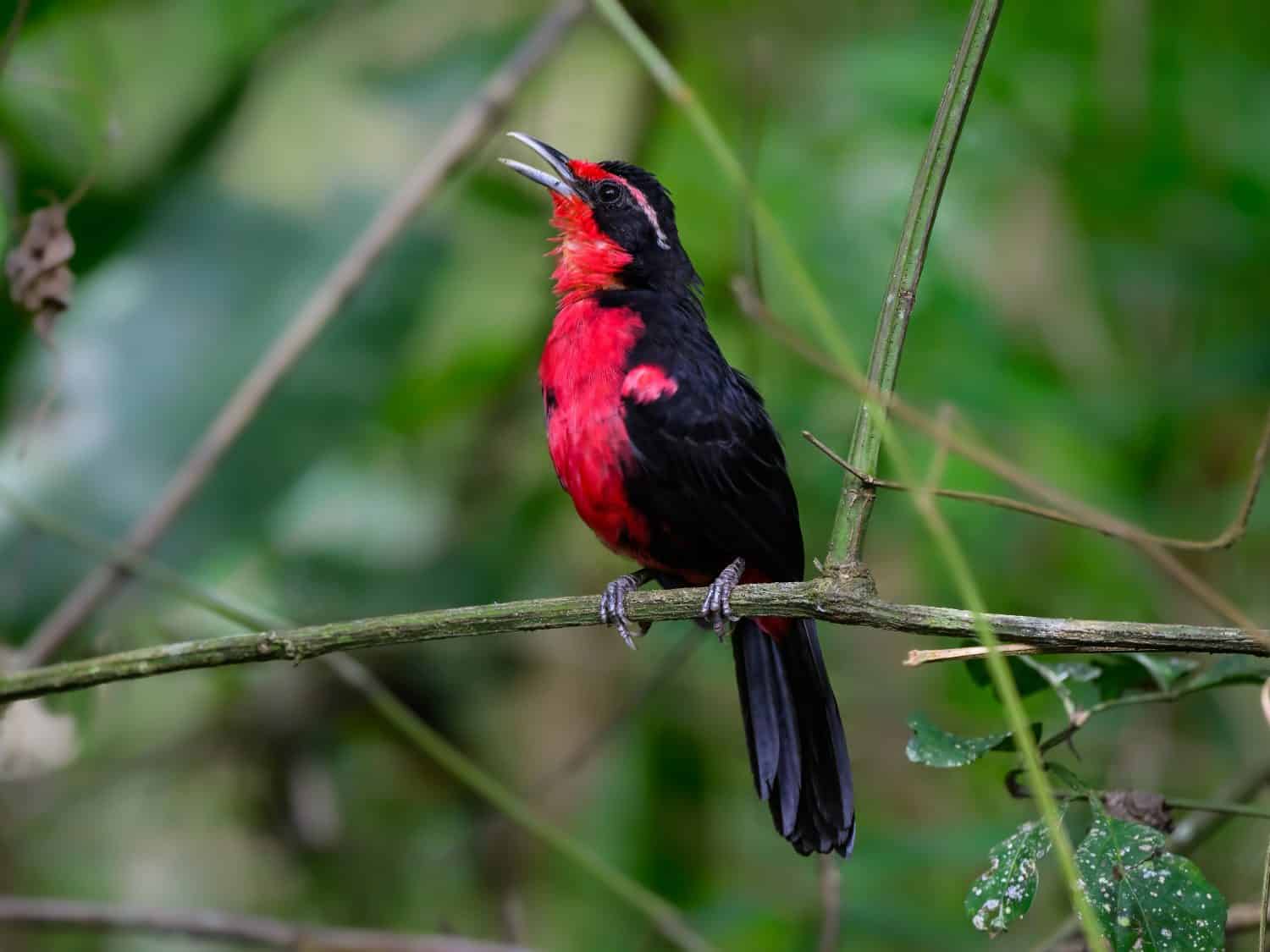
The rosy thrush tanager is the only tanager known to duet with its mate.
©FotoRequest/Shutterstock.com
This colorful bird of Costa Rica lives in tropical or subtropical forests and disturbed areas that used to be forests. It’s about 8 inches long, and the male has a brown-black upper body, dusky flanks, and his ventral parts and the leading edge of the wings are magenta. He also has a pink and white streak above his eye. The bird is shy but notable for its beautiful song, and pairs often duet. As far as scientists know it’s the only tanager that does this. The rosy thrush tanager is omnivorous and in Costa Rica its breeding season lasts from winter to late summer. Its conservation status is least concern.
7. Blue Grosbeak
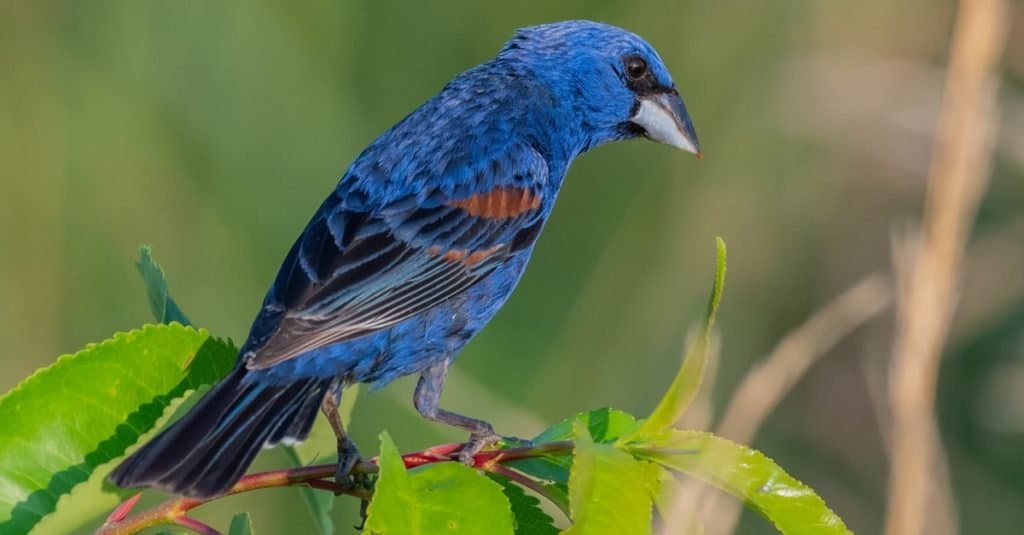
Some blue grosbeaks live in Costa Rica all year, while others visit during the winter.
©Jim Beers/Shutterstock.com
Named for the male’s lapis lazuli feathers and the large, nut cracking bill shared by both sexes, some populations of this bird winter in Costa Rica while others live there year-long. They prefer areas with low growing shrubs or trees, usually at the edges of woods or forests.
Blue grosbeaks are between 5.9 and 6.3 inches long and weigh between 0.92 and 1.09 ounces. Besides the predominantly blue feathers, the males’ primary flight feathers are black, and they have brown wing bars on the covert feathers and a streak of brown from their beak to their eye. Females are basic brown with a few blue feathers and mostly black wings. They are the ones who build the nests during the April to August breeding season.
Hens lay three to five eggs. The male feeds her as she incubates the eggs for 11 to 12 days. Both parents feed the chicks, which fledge as early as nine or 10 days after they hatch. Blue grosbeaks often breed twice a year, and the female builds another nest for the next brood. Interestingly, this time the male mostly takes care of the chicks. Blue grosbeaks probably live a little less than six years, and their conservation status is least concern.
8. Indigo Bunting
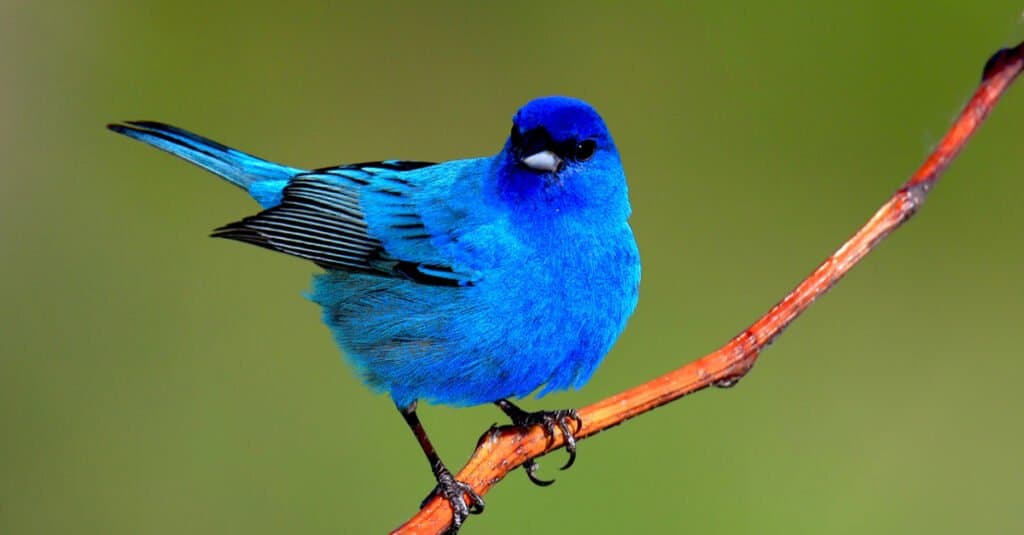
The indigo bunting likes areas where forests have been cleared.
©John L. Absher/Shutterstock.com
You’ll find the beautiful indigo bunting in Costa Rica during the winter. Related to the cardinal, it’s a little bird between 4.5 and 5.9 inches long with a 7-to-9-inch wingspan, and weighs between 0.40 and .075 of an ounce. The male’s blue feathers are especially vivid during the breeding season, but in Costa Rica his plumage is a bit more subdued and edged with brown. The female is brown all the time.
The indigo bunting prefers open woods and the edges of forests and farms. They prefer areas where forests have been cleared. The bird migrates at night and uses the stars to guide it. After it arrives at its winter habitat, the indigo bunting feeds in flocks on the ground and mostly eats grass seeds, buds and insects. Its conservation status is least concern.
9. Hummingbirds
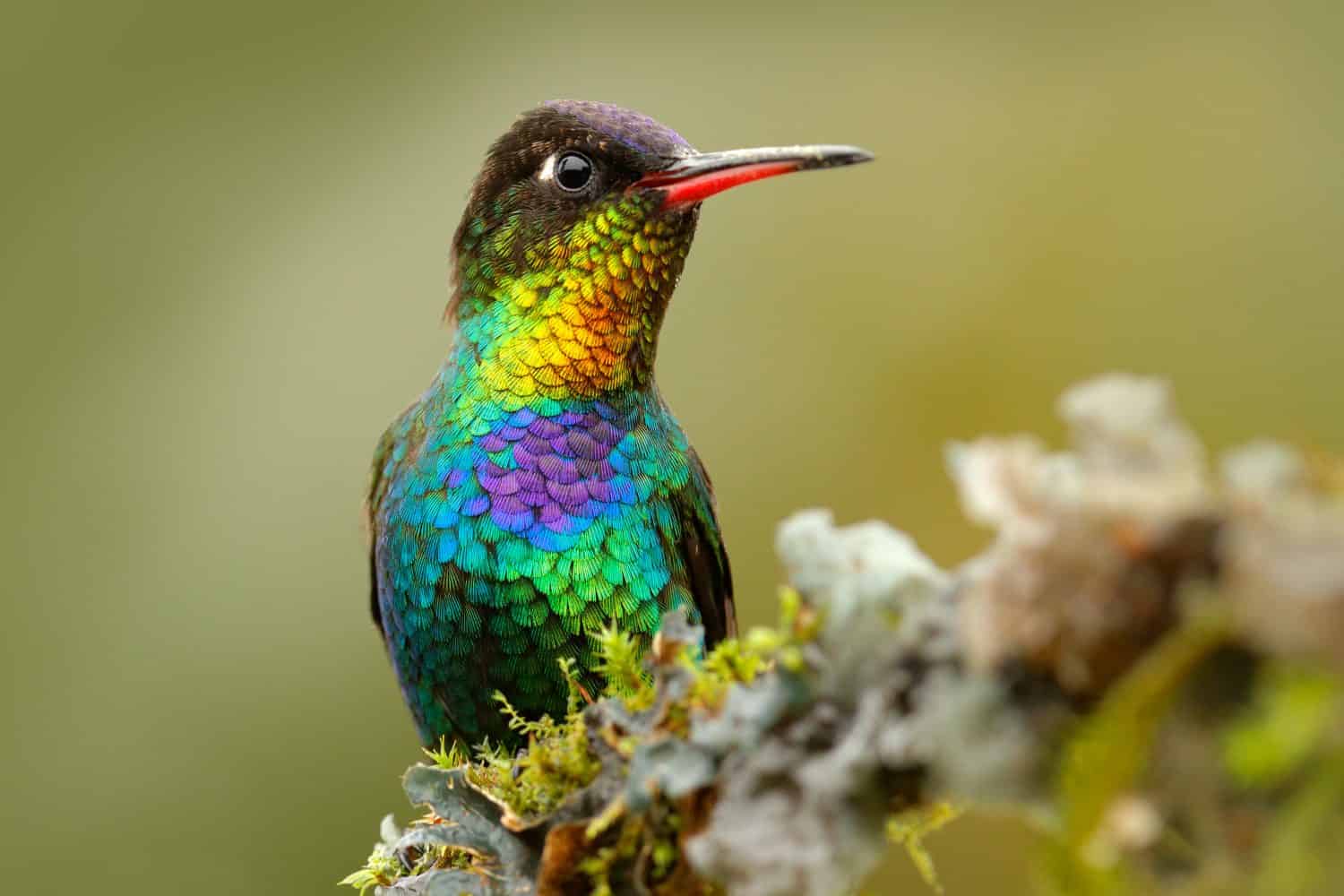
The fiery-throated hummingbird belongs to the
Panterpegenus and is its only member.
©Ondrej Prosicky/Shutterstock.com
Costa Rica has a wealth of jewel-toned hummingbirds. Some of the more colorful are:
- Coppery headed emerald, which is only found in Costa Rica
- Green-crowned brilliant
- Purple throated mountaingem
- Sapphire-throated hummingbird
- Fiery-throated hummingbird
- Garden emerald
- Canivet’s emerald
- Coppery-headed emerald
- Violet sabrewing
- Ruby-throated hummingbird
- Green hermit
- Blue-vented hummingbird
Hummingbirds belong to the Apodiformes order and mostly sip nectar from usually funnel shaped flowers. Indeed, there are hummingbirds whose bills have evolved to drink from only one type of flower. Specialized bones in their wings and powerful muscles let hummingbirds hover in the air and even fly backwards.
10. Green Honeycreeper
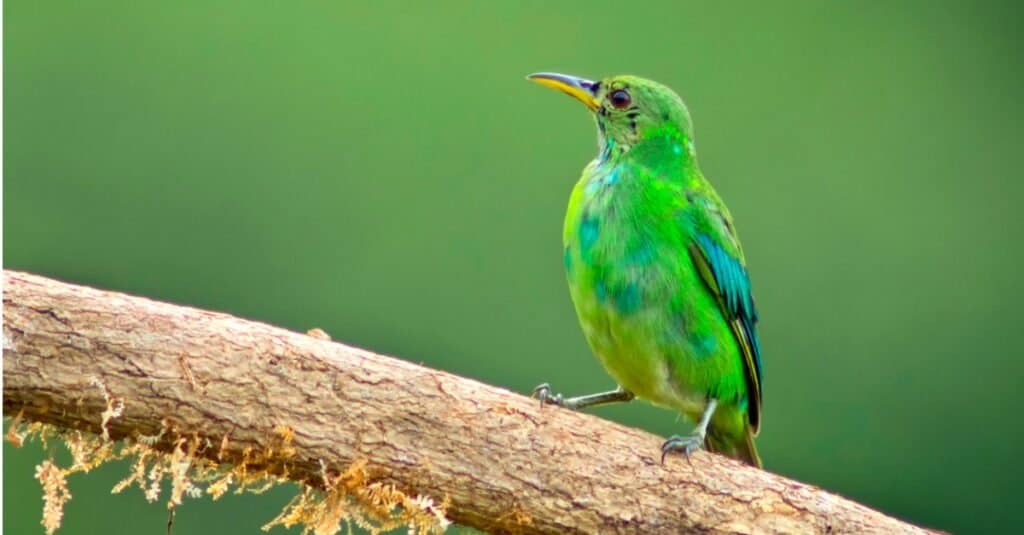
The curved bill of the green honeycreeper helps it get nectar from flowers, but it also eats insects and fruit.
©iStock.com/Alberto Carrera
The only member of the Chlorophanes genus, both the male and the female of this tanager are colorful. The female is shades of bright green, while the male is blue green, with an iridescent black head and a bright yellow, slightly curved beak. The bird is about 5.1 to 5.5 inches long and weighs between 0.49 and 0.81 of an ounce. You’ll find them in Costa Rica’s forest canopy. It gets its name because it eats nectar, but it also eats fruit, seeds, and insects. There are seven subspecies of the green honeycreeper, and its conservation status is least concern.
11. Roseate Spoonbill
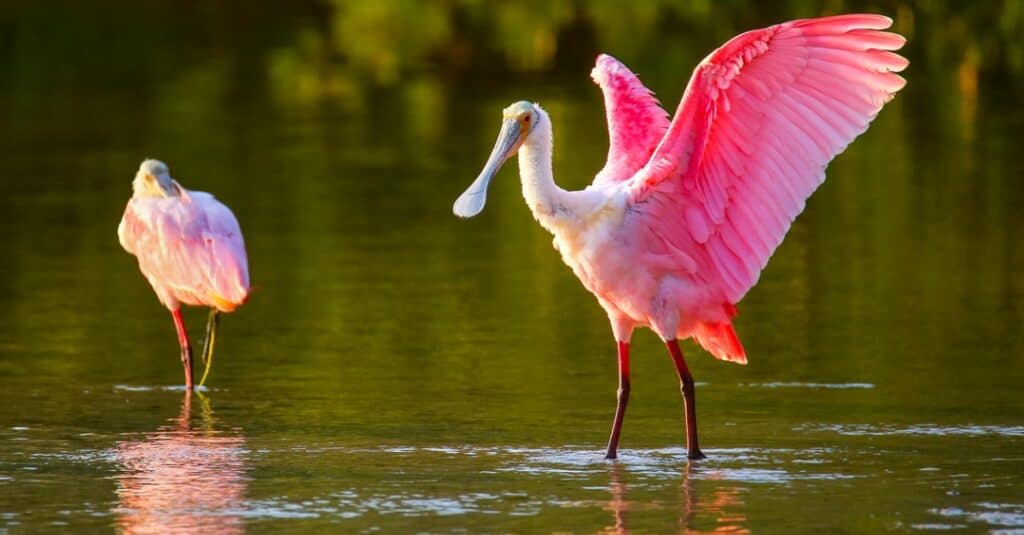
This colorful bird in Costa Rica gets its pink color from what it eats.
©iStock.com/Donyanedomam
This large wading bird is known for its long spatulate bill and its wonderfully pink feathers. You’ll find it in brackish marshes and mangroves.
The roseate spoonbill is 32 inches long, has a 47-to-52-inch wingspan and usually weighs between 2.28 and 4.0 pounds. It has a bare green head that turns golden during the breeding season. The back, breast and upper neck are white, and the rest of the bird ranges in color from sugar pink to deep carmine. Unlike some of the birds mentioned here, males and females look alike. The roseate spoonbill’s color comes from its diet. This includes crustaceans, insects, minnows, and some plant material scooped out of muddy water by its beak.
The bird is also known for building huge nests in trees or shrubs, where the hen lays an average of three eggs that hatch after around 23 days. The roseate spoonbill used to be hunted aggressively for its feathers, but now its conservation status is least concern.
12. Purple Gallinule
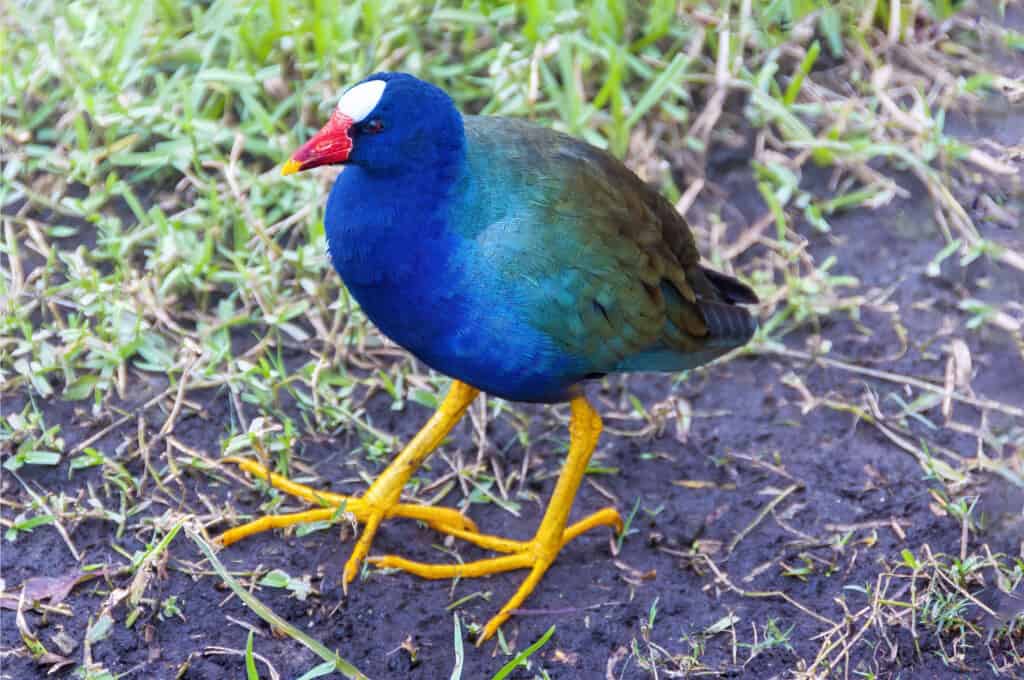
The purple gallinule’s large feet help it walk over floating vegetation.
©iStock.com/barbaraaaa
This bird is known as much for its huge yellow feet as its colorful plumage. It’s a type of rail, usually 10 to 15 inches long and weighing between 5.0 and 10.8 ounces, with the males a bit larger than the females. They have purplish blue feathers that turn emerald green or turquoise when the sun strikes them. Their foreheads bear a blue shield, and their bill is bright red at the back and yellow at the tip. The size of their feet helps them walk over floating vegetation in the watery habitat where they live. Purple gallinules even build their nests on the water. They’re omnivores and eat terrestrial and aquatic plants as well as small invertebrates, insects and their larvae, and frogs. Purple gallinules aren’t above robbing the nests of other birds for their eggs or chicks.
13. Scarlet Macaw

One of
themost colorful birds of Costa Rica, scarlet macaws can live as long as 75 years.
©Ondrej Prosicky/Shutterstock.com
One of the most colorful birds on earth, the scarlet macaw looks like someone artfully tossed cans of primary color paint all over it. Found in Costa Rica’s tropical rainforest, this bird’s head and shoulders are scarlet, and there’s bright yellow and blue on their wing feathers and blue on the tail feathers. There are white feathers on the bird’s face around yellow eyes. The top of the scarlet macaw’s beak is light colored while the bottom is black as are its feet and legs. These birds are about 35 inches long, and between one third and one half of that length is the macaw’s spectacular tail.
Scarlet macaws have a diet of fruit and nuts, and they often eat fruit before they’re ripe. Their huge bills are able to tear through unripe fruit and crack nuts. Not only this, but they also have a mechanism inside their beaks that allow them to grind nuts and seeds. These parrots also eat clay found at riverbanks to help them digest unripe fruit.
They weigh about 2.64 pounds on average. Males and females look alike, and they mate for life. They’re also devoted parents, and though they can breed all year, they won’t start another family until the previous brood is independent. This can take one to two years. Scarlet macaws are ready to breed when they’re between two and four years old. They live as long as 50 years in the wild and as long as 75 years in captivity. Though their population is under pressure from habitat destruction and poaching, the conservation status of the wondrous scarlet macaw is least concern.
14. Turquoise-Browed Motmot

These birds raise their chicks in burrows they dig into the sand at the banks of rivers.
©Martin Pelanek/Shutterstock.com
This bird is found on the edges of forests, pastures and scrublands. If you’re in Costa Rica, you may see it perching on fences or telephone wires as it looks out for potential prey such as worms, lizards, beetles, caterpillars and other invertebrates. These birds prefer to live in rocky crevices and terraces, and they dig burrows into sandy river banks. These burrows are used as nests during the breeding season and can be as much as 8 feet long.
The turquoise browed motmot is about 13 inches long and weighs a little over two ounces. The male is a bit larger than the female. Its body is mostly grayish blue or olive green, though there are areas of chestnut on the back and the belly. It has a patch of black on its throat that’s edged in blue, and the flight feathers and the upper part of the tail are also blue. The long tail ends in rackets at the end of bare shafts. The rackets are there for both courtship and to let a predator know that the bird has seen it and chasing it is futile. Both sexes have rackets, but the male’s tail is longer. The motmot gets its name from the turquoise blue line above its eye. Its conservation status is least concern.
15. Resplendent Quetzal
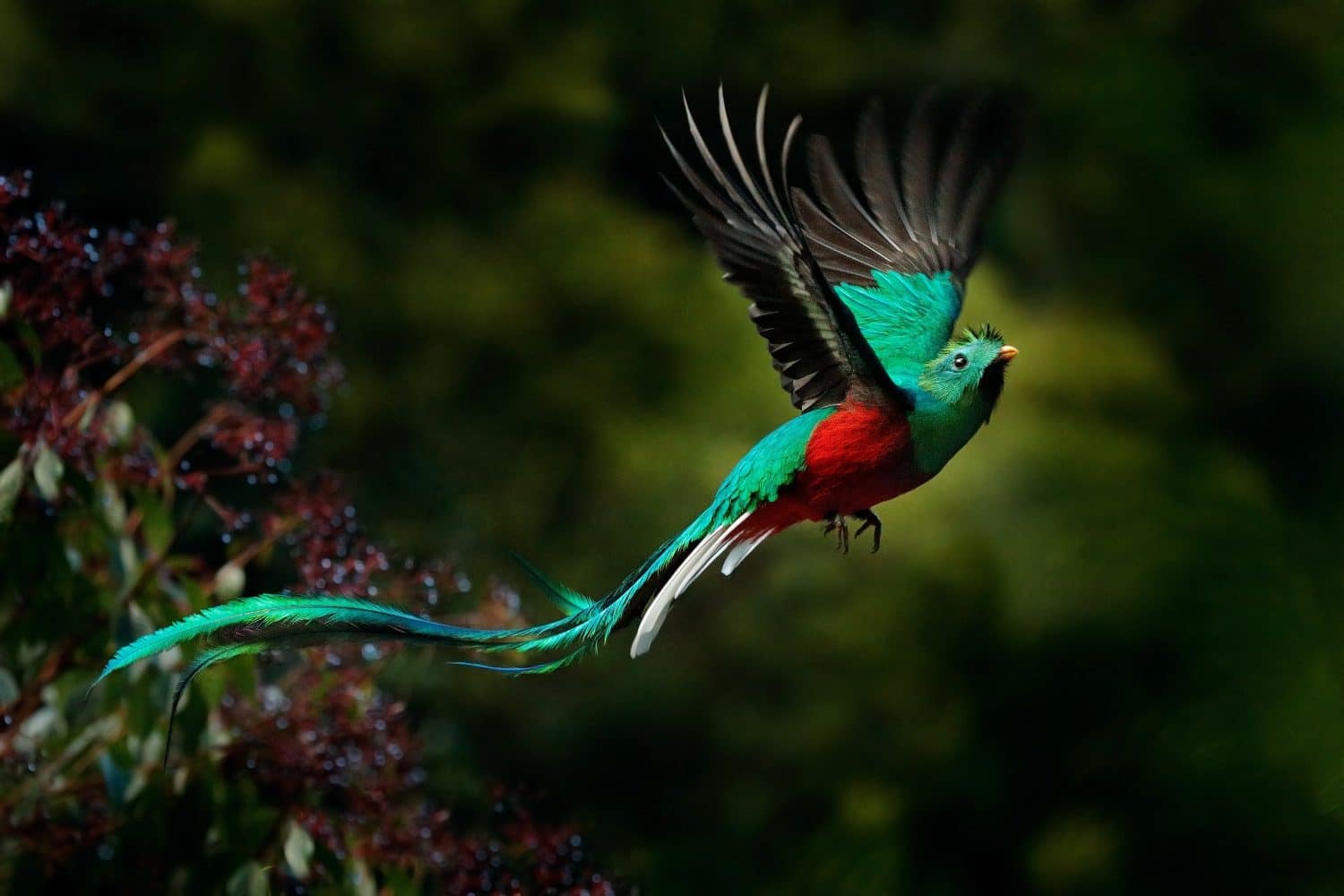
The resplendent quetzal’s tail can be as long as 3 feet.
©Ondrej Prosicky/Shutterstock.com
You’ll find this extraordinary bird in tropical and cloud forests in the mountains. The males have sensational plumage of iridescent green and the feathers change color depending on the angle and quality of the light. The bird’s lower breast and belly are red, it has a crest, its undertail is white, its inner wings are black, and its tail coverts are extraordinarily long. They can be as much as 3 feet long in a bird that is otherwise the size of a pigeon. Females are by no means dull, but they’re not as vibrant as the male. They lack a crest, and their tail is shorter. The bird’s feathers are also thick to protect its delicate skin. The colors of this colorful bird from Costa Rica are not to delight humans but to camouflage it in the tropical rain forest.
Resplendent quetzals are largely fructivorous, though they can also eat insects, frogs, snails, and small reptiles. Still, they are partial to fruit from the laurel family. They can swallow these fruits whole and then spit out the pits and seeds. There are two subspecies of the resplendent quetzal, and Pharomachrus mocinno costaricensis is, as its name says, found in Costa Rica. The conservation status of this amazing bird is near threatened.
For a long time, it was believed that the resplendent quetzal simply couldn’t be held in captivity, for it always died, and it became a symbol of freedom to many. It was then discovered that the bird couldn’t tolerate the iron found in the water it was given to drink. Birds survived after their diet was corrected.
16. Keel-Billed Toucan

Scientists don’t know what the toucan’s huge bill is for exactly, but it helps the bird pluck fruit from trees.
©David Havel/Shutterstock.com
How does this bird manage to carry its enormous, rainbow-colored bill? It’s because the bill, made of hollow bone and keratin, is lightweight. It’s about 4.7 to 5.9 inches long, and the rest of the bird is between 14 and 18 inches long. The keel-billed toucan gets its name because the edges of the bill have ridges that resemble teeth. The bird’s feathers are mostly deep black, with a bright yellow bib and red at the end of its tail. Its feet are blue, and the bill has splashes of green, red, orange, and purple. Males and females look alike but males are a little larger. You’ll find the keel-billed toucan on the edges of forests and in lowland forests in Costa Rica.
This toucan eats mainly fruit but it also takes small reptiles, tree frogs and insects and isn’t above stealing the eggs and chicks of other birds. It either spits up larger seeds or lets smaller ones pass undamaged through its digestive tract, which helps repopulate the forest. Like the resplendent quetzal, it is sensitive to too much iron in its diet. The keel-billed toucan is the national bird not of Costa Rica but of Belize. Its conservation status is near threatened thanks to habitat loss and poaching.
The photo featured at the top of this post is © Super Prin/Shutterstock.com
Thank you for reading! Have some feedback for us? Contact the AZ Animals editorial team.







